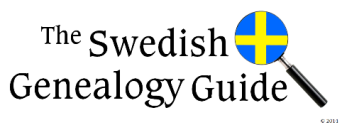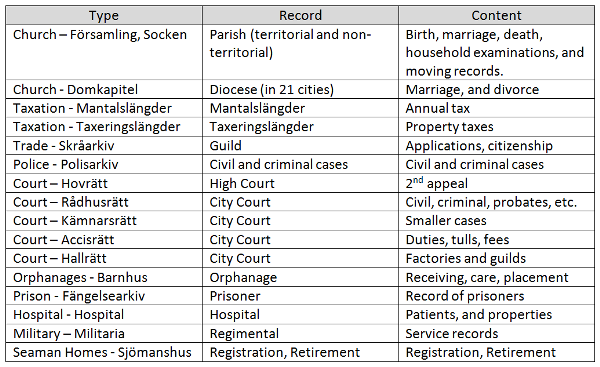Chances are at some point you will find a Swedish ancestor that lived in a city. You’ll find that genealogical research in cities is different than in rural areas. The parish was still responsible to keep the vital records of birth, marriage, and death, but there are unique differences due to city life. This article will help you understand those differences and offer some resources to find your ancestors in the cities.
Historically the largest cities in Sweden have been Stockholm, Göteborg, Malmö, and Norrköping. When you rank the cities by size, you’ll find the order of largest to smallest varies according to time period. Stockholm was the largest city beginning in the late 1500’s and has been ever since. Before 1850 Stockholm and Göteborg were the only cities with a population over 20,000. Between 1850 and 1930 the population of Stockholm increased to 500,000, and Göteborg to about 250,000. In the same time period Malmö breaks 100,000 and Norrköping hits about 70,000.
Life in the Cities
Life in cities is built upon manufacture, distribution, and trade. In Sweden the government controlled the privileges of a town or city to participate in these activities. All the larger cities were ports for trade. These cities also had a stronger military presence.
The cities had a wider diversity of people from other countries. These people brought other languages, traditions, naming customs, and religions. Although Sweden had the Lutheran state church, they allowed other groups of people to practice their respective faith. As the natural resources and opportunities vary by location, you find that towns and cities became known for certain products.
Challenges of Research in Cities
There are many challenges to finding your ancestor in the cities. Here are some of the big ones:
Population Size
Simply put, the larger the community.. the harder to find the person that you’re looking for. Sometimes in the larger cities, it can feel like searching for a needle in a haystack.
Migration
Every city started out as a small village. Over time people moved to the cities for opportunities. Once in a city, a person might move for a better job or better housing. Workers in cities were not tied to the land. There was job stability and in-stability. Many workers had to renew an annual contract. Relocation was common, and just like today having connections was important. All these situations lead to the questions of “where did this person come from?” or “where did they go to?”
The Church in the Cities
A priest in the Swedish Lutheran church was responsible for keeping birth, marriage, and death records for all the people that lived within their parish boundary. These are called Territorial parishes because they have a geographic boundary. In the larger cities, there are congregations that gather for other reasons such as language, or the military. These parishes are called Non-territorial parishes because there isn’t a geographic boundary within the city. In most cases there is a city parish (Stadsförsamling) for people who lived in the city, and a rural parish (Landsförsamling) for the people who lived near the city.
Because there were so many people to keep track of, the parish priest and his staff struggled to keep accurate household examination and moving records. As the population increased and the number of members within a parish increased, the diocese would split the older parish to create a new parish. Statistically there were higher rates of illegitimate births in the cities. This was especially true between 1778 and 1917 when a mother could give birth anonymously. Residency in the records is listed by Rote (like a neighborhood), streets, or even households within a building.
Naming customs
After moving to the city, many people changed their surname for practical reasons. There were too many people with similar names. To change a surname was easy, just start using it. Over time your new surname would become what you’re known by with your friends, family, employer, on the church records, and with tax authorities. The challenge is finding what the patronymic surname was before moving to the city. Also, there was a wider variety of given names in the cities, many of which came from other countries.
Orphanages
There were many situations that led a child to the orphanage. It could be the death of parents, a single parent unable to provide for a child, or a temporary situation of failing health, or imprisonment. Whatever the case, children were taken to orphanages for care. All cities were required to have an orphanage according to the law of 1624. There were public and private orphanages. See the article Orphanages in Sweden on the FamilySearch Wiki.
Military
The larger cities had an increased military presence made up of professionals, and non-professionals in the army or navy. They lived in military quarters and belonged to military church congregations. The question is “where did they come from” and after their service “where did they go to?”
Records in Cities
There are many records available to search for your ancestor in a Swedish city. Here is a short list:
Here are some resources for genealogical research in Swedish Cities:
Stockholm
- Tidigmoderna konkurser 1687 – 1849, see Tidigmoderna konkurser databas
- Mantalslängder 1760 (Stockholm City Archive)
- Mantalslängder 1810 (Stockholm City Archive)
- Mantalsuppgifter 1835, 1845, 1860, and 1870 (Stockholm City Archive)
- Mantalsregister 1800-1884 (Stockholm City Archive)
- Indexes for parishes in PDF, through Stockholm Stadsarkiv website at: Kyrkoarkiv
- 1878-1926 Roteman database (Stockholm City Archive), also available for purchase on DVD through Sveriges Släktforskarförbund.
- 1926-1939 Överståthållarämbetet, available through Arkiv Digital.
- For orphanages see the article: Orphanages in Sweden on the FamilySearch Wiki.
Göteborg
- Index of Marriages for Kristine parish 1624 – 1774, FHL Intl book 948.69/G1 H2b v.3
- Rådhusrätt register 1719 – 1798, FHL microfilm Intl 216069 – 216070
- Göteborg tomtägare 1637 – 1807 at: Göteborgs tomtägare 1637 – 1807
Malmö
Norrköping
- Tax records index for all tax obligated 1727-1945 at the Norrsköping Stadsarkiv. Contact the archive for assistance.
Resources for Other Cities
1. PLF (Person-och Lokalhistoriskt Forskarcentrum) on CD for all cities in Småland (Jönköping, Kalmar, and Kronoberg Counties.) These include: Borgholm, Eksjö, Gränna, Huskvarna, Jönköping, Kalmar, Oskarshamn, Vimmerby, Västervik, and Växjö
2. Demografisk Databas Södra Sverige (DDSS) for Skåne (Malmöhus, Kristianstad), Blekinge, and Halland Counties. These include entries from birth, marriage, and death records of: Båstad, Helsingborg, Höganäs, Karlskrona, Kristianopel, Kristianstad, Malmö, Ronneby, Vä, Ystad, Åhus, and Ängelholm. Within DDSS there is the Halland Marriage Database that will help for the cities of Falkenberg, Halmstad, Kungsbacka, Laholm, and Varberg.
3. Indiko (Demografiska databasen Umeå universitet) for Linköping, Skellefteå, and Sundsvall.
4. Födda, Vigda, Döda i Ådalen, CD available at FHL or can be purchased through Riksarkivet for Härnösand and Sollefteå.
5. Register of births, marriages, and deaths in Jämtland 1642-1860 on FamilySearch.org, 1686-1875 on microfilm INTL 1644180 for Östersund.

